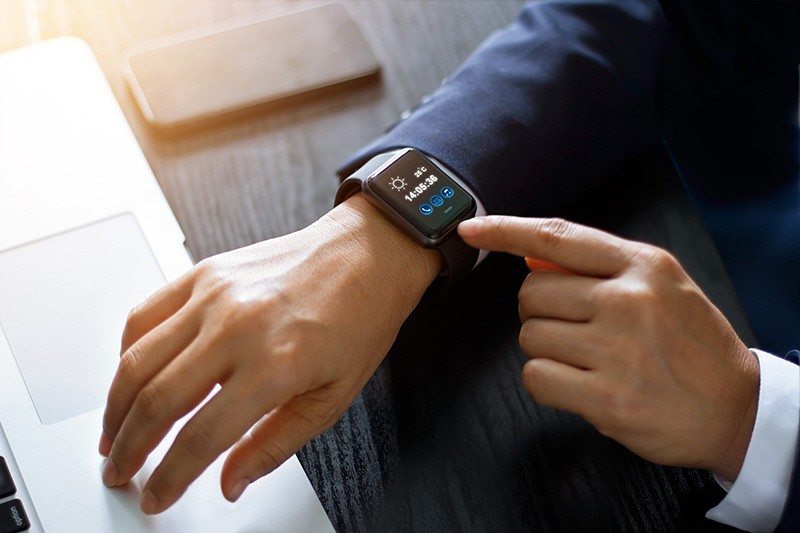The era of wearable technology has dawned, seamlessly integrating digital intelligence into our daily lives. No longer just futuristic gadgets from science fiction, these discreet yet powerful devices are fundamentally reshaping how we live, work, and interact with the world. From tracking our health and fitness to streamlining communications and enhancing our senses, wearables are evolving beyond mere accessories into indispensable tools that offer immediate, personalized insights and interactions. This comprehensive exploration delves into the cutting-edge advancements driving this revolution, its profound impact across diverse sectors, the significant challenges it faces, and its essential role in ushering in an era of truly smart, connected living. Understanding this pervasive technological shift is crucial for anyone navigating the intricate tapestry of the 21st-century digital landscape.
Defining Wearables
![]()
While smartwatches might be the most common image, the world of wearables is far more expansive, encompassing any electronic device worn on the body as an accessory or part of clothing. Their core function is to collect, process, and transmit data, often in real-time, about the user or their environment.
A. The Evolution of Wearable Tech
The concept of wearable technology isn’t entirely new, but its modern form is a product of miniaturization and advanced computing.
- Early Concepts: Think of the abacus rings or even early calculators worn discreetly. Practical wearable computers began emerging in the 1980s and 90s, though they were bulky and limited.
- Fitness Trackers (Early 2000s): Simple pedometers evolved into devices that tracked steps, calories, and basic sleep, igniting the consumer wearable market.
- Smartwatches (2010s): The launch of devices like the Apple Watch brought comprehensive health tracking, notifications, and app integration to the wrist, pushing wearables into the mainstream.
- Miniaturization and Power Efficiency: Advancements in microprocessors, battery technology, and sensor development enabled smaller, more powerful, and longer-lasting devices.
- Connectivity (Bluetooth, Wi-Fi, Cellular): Seamless communication with smartphones and the cloud became standard.
- AI Integration: Modern wearables increasingly incorporate AI for more intelligent data analysis, personalized coaching, and predictive insights.
This rapid evolution reflects a continuous drive to make technology more personal, intuitive, and seamlessly integrated with the human experience.
B. Categories of Modern Wearables
The wearable landscape is highly diverse, with devices designed for various purposes and worn on different parts of the body.
- Smartwatches: The most popular category, offering timekeeping, notifications, fitness tracking, health monitoring (heart rate, ECG, blood oxygen), contactless payments, and sometimes cellular connectivity. Examples include Apple Watch, Samsung Galaxy Watch, Google Pixel Watch.
- Fitness Trackers (Activity Bands): Simpler devices primarily focused on health and fitness metrics like steps, distance, calories burned, sleep quality, and heart rate. Examples include Fitbit, Xiaomi Mi Band.
- Hearables (Smart Earbuds/Headphones): Beyond audio playback, these can offer fitness tracking, real-time language translation, ambient noise control, and even hearing enhancement. Examples include Apple AirPods Pro, Samsung Galaxy Buds.
- Smart Glasses (Augmented Reality Glasses): Devices that overlay digital information onto the real world. While still nascent for mass consumer adoption, they hold immense potential for navigation, remote assistance, and immersive experiences. Examples include Microsoft HoloLens (enterprise), Ray-Ban Meta Smart Glasses (consumer).
- Smart Clothing and Textiles: Apparel embedded with sensors to monitor vital signs, track athletic performance, or provide haptic feedback. Examples include smart shirts, smart socks, and smart shoes.
- Smart Jewelry: Rings, pendants, or bracelets that discreetly integrate fitness tracking, notifications, or emergency alerts. Examples include Oura Ring, Motiv Ring.
- Medical Wearables: Specialized devices for continuous glucose monitoring, remote patient monitoring for chronic conditions, or seizure detection. These often require regulatory approval.
- Exoskeletons: Wearable robotic devices that augment human strength or assist individuals with mobility impairments.
This broad spectrum highlights the versatility and growing sophistication of wearable technology.
C. Core Technologies Powering Wearables
The capabilities of modern wearables are built upon a foundation of miniaturized yet powerful technologies.
- Miniaturized Sensors:
- Accelerometers and Gyroscopes: Detect motion, orientation, and steps for activity tracking.
- Optical Heart Rate Sensors (PPG): Use light to measure blood flow and infer heart rate, blood oxygen (SpO2).
- Electrocardiogram (ECG) Sensors: Detect electrical activity of the heart for more accurate cardiac rhythm analysis.
- Temperature Sensors: Monitor body temperature variations for health insights.
- GPS/GNSS Modules: Provide location tracking for outdoor activities and navigation.
- Barometers/Altimeters: Measure atmospheric pressure for elevation tracking.
- Electrodermal Activity (EDA) Sensors: Detect changes in skin conductivity, often linked to stress levels.
- Low-Power Processors (SoCs): Highly efficient system-on-a-chip designs that can perform complex computations while conserving battery life.
- Wireless Connectivity:
- Bluetooth Low Energy (BLE): The primary protocol for short-range communication with smartphones, optimized for low power.
- Wi-Fi: For faster data transfer and direct internet access in some devices.
- Cellular (LTE/5G): Enables standalone operation for calls, messages, and streaming without a paired smartphone.
- Advanced Batteries: Miniaturized, high-density batteries that offer extended operating times, often utilizing lithium-ion polymer technology.
- Display Technologies: AMOLED or LCD screens optimized for small form factors, brightness, and power efficiency.
- AI and Machine Learning Algorithms: Process raw sensor data, identify patterns, filter noise, and generate actionable insights (e.g., sleep stage detection, personalized workout recommendations, stress level analysis).
- Cloud Computing Integration: Syncing data with cloud platforms for long-term storage, deeper analysis, and access across multiple devices.
The synergy of these technologies allows wearables to be compact, powerful, and seamlessly integrated into our lives.
Wearables’ Transformative Impact Across Industries
The pervasive nature of wearables means their influence extends far beyond personal gadgets, revolutionizing various sectors.
A. Healthcare and Wellness
This is arguably the most impactful area for wearables, empowering individuals with continuous health monitoring.
- Proactive Health Management: Wearables collect real-time data on heart rate, sleep patterns, activity levels, and more, allowing users to track trends and make healthier lifestyle choices.
- Early Detection of Health Issues: Advanced wearables can detect potential health anomalies like atrial fibrillation (AFib), irregular heart rhythms, or significant changes in blood oxygen levels, prompting users to seek medical attention.
- Chronic Disease Management: Devices like continuous glucose monitors (CGMs) for diabetics or smart inhalers for asthmatics provide real-time data to patients and doctors, improving disease management.
- Remote Patient Monitoring (RPM): Healthcare providers can remotely track vital signs and other health metrics of patients at home, reducing hospital visits and improving care for the elderly or those with chronic conditions.
- Mental Well-being: Some wearables track stress levels through EDA or heart rate variability, offering guided breathing exercises or mindfulness prompts.
- Rehabilitation: Wearable sensors can monitor patient progress during physical therapy, ensuring exercises are performed correctly.
B. Fitness and Sports
Wearables have revolutionized how athletes and fitness enthusiasts train and track progress.
- Performance Optimization: Detailed metrics on pace, distance, elevation, heart rate zones, cadence, and even running dynamics help athletes fine-tune their training.
- Recovery Tracking: Sleep analysis, heart rate variability (HRV), and body temperature monitoring provide insights into recovery status, helping prevent overtraining.
- Personalized Coaching: AI-driven apps analyze wearable data to offer customized workout plans and real-time coaching feedback.
- Injury Prevention: By tracking biomechanics and fatigue indicators, wearables can help identify patterns that might lead to injury.
- Team Sports Analytics: Wearable sensors on athletes provide coaches with real-time performance data, informing strategic decisions and player management.
C. Enterprise and Industrial Workflows
Wearables are enhancing productivity, safety, and communication in professional settings.
- Worker Safety: Smart helmets with AR overlays providing real-time data, smart vests monitoring vital signs in hazardous environments, or wearables that detect falls or proximity to dangerous machinery.
- Remote Assistance: AR smart glasses allow frontline workers to receive real-time visual guidance from remote experts, reducing downtime and improving first-time fix rates.
- Training and Onboarding: Immersive VR/AR experiences delivered via wearables can provide realistic, hands-on training for complex procedures.
- Inventory Management: Wearable scanners or voice-picking systems in warehouses improve efficiency and accuracy.
- Communication: Smartwatches or hearables enable hands-free communication in noisy or hands-on environments.
D. Security and Access Control
Wearables are offering new layers of security and convenience.
- Biometric Authentication: Fingerprint or heart rate authentication on smartwatches for device unlock or payment authorization.
- Contactless Payments: NFC-enabled smartwatches and rings allow for quick and secure payments.
- Access Control: Wearables can function as digital keys for doors, vehicles, or secure areas.
- Emergency Alerts: Wearables can detect falls or allow users to trigger emergency calls with their location, crucial for elderly individuals or lone workers.
E. Gaming and Entertainment
Wearables are integral to creating more engaging and immersive entertainment experiences.
- VR/AR Gaming: VR headsets provide full immersion, while AR glasses blend games with the real world.
- Haptic Feedback: Wearables (e.g., haptic vests, gloves) can enhance gaming by providing tactile sensations, making interactions feel more real.
- Location-Based Games: AR wearables enrich real-world exploration games by overlaying digital content onto physical environments.
- Social Connectivity: Enabling seamless communication and interaction among players in virtual or augmented spaces.
The Challenges and Obstacles for Wearables

Despite their explosive growth, wearables face significant hurdles that must be addressed for broader adoption and sustained success.
A. Battery Life
This remains one of the most significant challenges for all portable electronics.
- Frequent Charging: Many smartwatches and AR glasses require daily or near-daily charging, which can be inconvenient for users.
- Trade-offs: Balancing advanced features (bright displays, cellular connectivity, continuous sensing) with battery longevity.
- Innovation: Research into more energy-efficient components, better battery chemistry, and alternative charging methods (e.g., kinetic energy harvesting, solar charging) is ongoing.
B. Accuracy and Reliability of Data
While improving, the accuracy of some wearable-collected data can be a concern.
- Sensor Limitations: Consumer-grade sensors may not always match the precision of clinical-grade medical equipment.
- Algorithm Dependence: The accuracy of insights often depends heavily on the algorithms interpreting raw sensor data, which can vary between manufacturers.
- User Variability: Factors like skin tone, body hair, and how tightly a device is worn can affect sensor readings.
- Medical vs. Wellness: Differentiating between devices certified for medical use and those intended for general wellness.
C. Privacy and Data Security
Wearables collect highly sensitive personal and biometric data, raising significant privacy and security risks.
- Personal Data Collection: Heart rate, sleep patterns, location, activity levels, and potentially even voice data are continuously collected.
- Data Breaches: The risk of this sensitive data being hacked or misused.
- Consent and Transparency: Ensuring users fully understand what data is being collected, how it’s used, and who it’s shared with.
- Data Monetization: Concerns about companies monetizing user data without explicit consent or fair compensation.
- Legal Frameworks: The need for robust regulations (like GDPR, CCPA) specifically addressing wearable data.
D. User Experience (UX) and Form Factor
Making wearables truly intuitive and seamlessly integrated is a continuous challenge.
- Display Limitations: Small screens on smartwatches limit complex interactions.
- Input Methods: Relying on touch, gestures, or voice can be cumbersome in certain situations.
- Comfort and Aesthetics: Devices need to be comfortable for continuous wear and aesthetically pleasing to encourage adoption.
- Interoperability: Ensuring seamless data syncing and compatibility between different wearable brands, apps, and ecosystems.
E. Cost and Accessibility
High upfront costs can be a barrier for many consumers.
- Premium Pricing: Advanced smartwatches and AR glasses can be expensive, limiting access to a broad market.
- Digital Divide: Exacerbating inequalities if access to health or productivity benefits of wearables is limited to those who can afford them.
- Charging Infrastructure: While less pronounced than EVs, the need for charging points for multiple devices can be a minor inconvenience.
The Future of Wearables
Despite the challenges, the trajectory for wearables is one of increasing sophistication, deeper integration, and greater utility, moving towards a future where they are an invisible yet indispensable part of our lives.
A. Enhanced Health Monitoring and Diagnostics
Wearables will become even more powerful tools for health.
- Non-Invasive Glucose Monitoring: Holy Grail for diabetics, allowing continuous glucose tracking without blood draws.
- Blood Pressure Monitoring: Integration of accurate blood pressure tracking into smartwatches or other wrist-worn devices.
- Advanced Biomarker Sensing: Detecting additional biomarkers (e.g., lactate, alcohol levels, stress hormones) through sweat or other non-invasive means.
- AI-Powered Predictive Health: More sophisticated AI models will analyze vast datasets from wearables to predict health risks and suggest preventative measures with greater accuracy.
- Digital Therapeutics: Prescribable wearable devices that deliver therapeutic interventions or monitor adherence to treatment plans.
B. Seamless Blending with Augmented Reality (AR)
AR glasses are poised to be the next major form factor in wearables.
- Contextual Information: Overlaying relevant digital information (e.g., navigation, product reviews, facial recognition for names) directly onto your field of vision.
- Real-time Translation: See live translation of conversations or text in your environment.
- Hands-Free Interaction: Control devices and access information through gestures, voice commands, or subtle eye movements.
- Immersive Communication: Holographic calls and shared digital workspaces that blend seamlessly with the physical world.
C. Deeper AI Integration and Personalization
Wearables will become truly intelligent personal assistants.
- Hyper-Personalized Coaching: AI will provide even more tailored recommendations for fitness, nutrition, and mental well-being based on a holistic view of your data.
- Proactive Assistance: Your wearable will anticipate your needs, suggest actions, or provide information before you even ask.
- Emotional AI: Sensing and responding to your emotional state, offering calming exercises or mood-boosting content.
- Cognitive Augmentation: Tools that enhance memory, focus, or learning through subtle prompts or feedback.
D. Energy Harvesting and Extended Battery Life
Solving the battery problem is paramount for ubiquitous wearables.
- Thermoelectric Generators: Harvesting body heat to power devices.
- Kinetic Energy Harvesting: Converting movement into electricity.
- Miniaturized Fuel Cells: More efficient and longer-lasting micro-fuel cells.
- Faster, Wireless Charging: More convenient charging solutions that require less frequent interaction.
E. Ubiquitous and Invisible Integration
The ultimate vision is for wearables to disappear into our daily lives.
- Smart Textiles: Clothing that is truly smart, embedding sensors and computing power seamlessly into fabrics.
- Biometric Implants: While controversial, future possibilities include very small, sub-dermal implants for health monitoring.
- Self-Powered Devices: Wearables that require no charging due to highly efficient energy harvesting.
- Cognitive Seamlessness: Interactions become so intuitive that the technology effectively disappears, leaving only the enhanced experience.
Conclusion
Wearable technology is not a passing fad; it’s a profound and ongoing revolution that promises to redefine our relationship with technology and ourselves. By seamlessly embedding digital intelligence onto our bodies, these devices offer unprecedented opportunities for personalized health, enhanced productivity, immersive entertainment, and more intuitive human-computer interaction. While challenges surrounding battery life, data privacy, and user experience persist, the relentless pace of innovation and the compelling benefits ensure their continued evolution. As wearables become even more sophisticated, discreet, and deeply integrated with AI and AR, they will empower us with real-time insights and unparalleled connectivity, paving the way for a future where technology truly adapts to us, augmenting our capabilities and enriching every aspect of our connected lives. The future is worn, and it’s getting smarter every day.









